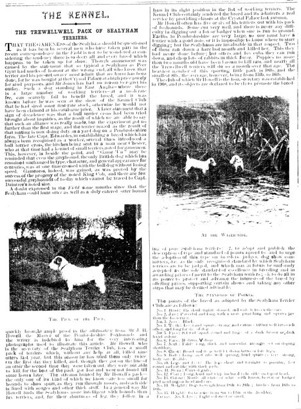sealyham century site


sealyham century site


The Trewellwell Pack of Sealyham Terriers.
“The Field” magazine, 1911.

That the gameness of the Sealyham should be questioned as it has been by several men who have taken part in the recent correspondence in the Field is not to be wondered at considering the tendency there is to decry all and every breed which happens to be taken up for show.
Though amusement was caused by the statement that so typical a Sealyham as Peer Gynt had marks of honour at the wrong end, all who know that terrier and his present owner must admit that no harm has been done, for he was bought at the Crystal Palace at a high price purely for stud purposes and Mr Jones has had no reason to regret his outlay. Such a dog standing in East Anglia - where there is a large number of working terriers - at a moderate fee, can scarcely fail to benefit the breed, and it was known before he was seen at the show of the Kennel Club that he had sired some first-rate stock, otherwise he would
not have been claimed at his catalogue price. A later statement that a sign of decadence was that a bull terrier cross had been tried brought about inquiries, as the result of which we are able to say that such an alliance was really made, but the experiment got no further than the first stage, and the terrier reared as the result of that mating is now doing duty as a yard dog on a Pembrokeshire farm.
The late Capt. Edwardes, in establishing a breed which has always been recognised as a worker, several times introduced a bull terrier cross, the bitches being sent to a man near Chester, who at that time had a kennel of small terriers noted for gameness. This, however , is beside the point and “Game Un” may be reminded that even the greyhound, the only British dog which has remained unchanged in type, character and general appearance for centuries, was at one time crossed with the bull dog without losing speed. Gameness, indeed, was gained, as was proved by the success of the progeny of the noted King Cob, and there are few successful greyhounds of today which cannot be traced to Capt. Daintree´s noted sire.
A doubt expressed in the Field some months since that the Sealyham could hunt otter as well as a duly entered otter hound quickly brought ample proof in the affirmative from Mr J. H. Howell, the Master of the Pembrokeshire Foxhounds, and the writer is indebted to him for the very interesting photographs used to illustrate this article. Mr Howell , who is the secretary of the Sealyham Terrier Club, has a small pack of terriers which , without any help at all, killed nine otters last year, but this season he has tried them only twice. On the first day they killed, and , though they got on the line of an otter the second time they were taken out, they were not able to kill , for the best of the pack got lost and were not found till some hours later. The streams hunted by Mr Howell´s pack - the only one of its kind of which we know - are too small for hounds to show sport, as they run through moors, and each side is lined with sedges and other thick stuff. In a general way Mr Howell finds the Sealyhams more intelligent with hounds than fox terriers, and , for their shortness of leg, they follow in a remarkable way.
The Trewellwell Sealyhams also seem to be able to find their way home from long distances without any difficulty, invariably getting back to kennels the same night, and they also are very useful in thick short furze for forcing out rabbits to the gun. They are of course not mute, and are more easily kept in check than the rabbit beagle which provides such good sport on the Southdowns and the rough ground bordering the hills which divide Surrey and Sussex. As a fact there seems to be no limit to the utility of the Pembrokeshire terrier, and could Mr Howell only be persuaded to bench his pack - not necessarily for competition - at Birmingham, Crufts or Manchester, the breed would be brought to the notice of men who might easily be induced to offer the support which is needed to place the Sealyham in its right position in the list of working terriers. The Kennel Club certainly rendered the breed and its admires a real service by providing classes at the Crystal Palace last autumn.
Mr Howell often has five or six of his terriers out with his pack of foxhounds. Some run very well and there is never any difficulty in digging out a fox or badger when one is run to ground. Earths in Pembrokeshire are very large , so one must have a terrier with a good note, or it is impossible to know where to start digging; but the Sealyhams are invaluable in that respect. Two of them ran down a hare last month and killed her. This they had never done before; but otters and fox cubs they can run down and shop lots of rabbits in the thick furze. Puppies no more than two months old have been known to kill rats and nearly all the Trewellwell terriers will do so a month over that age. The heaviest member of this sporting little pack is 18lb. and the smallest 8lb., the average, however, being from 15lb. to 16lb. The club of which Mr Howell is the hon. secretary was established in 1908, and its objects are declared to be (1) to promote the breeding of pure Sealyham terriers; (2) to adopt and publish the description of type and standard of points agreed to and to urge the adoption to this type on breeders, judges , dog show committees, &c., as the only recognised standard by which Sealyham terriers are to be judged, and which may in future be uniformly accepted as the sole standard of excellence in breeding and in awarding prizes, supporting certain shows and taking any other steps that maybe deemed advisable.

Photos from right; “The Pick of the Pack”, At the Water-side, The Trewellwell Sealyhams and their Master.

